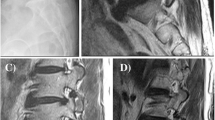Abstract
Background: Posterior lumbar interbody fusion (PLIF) has become the standard in the treatment for degenerative spondylolisthesis since improvement of spinal instrumentation However, few published studies have reported long term outcomes of PLIF using a same surgical procedure. The purpose of this study is to evaluate a long term outcome of PLIF using a same surgical procedure for L4-L5 degenerative spondylolisthesis.
Materials and Methods: Out of 45 patients who underwent L4-L5 PLIF for degenerative spondylolisthesis between 1995 and 2003, 37 patients (16 males and 21 females) were evaluated in this study. Mean age was 61.8 years. The average followup period was 121 months. We evaluated % slip, lordosis at L4/L5, lumbar lordosis, Japanese Orthopedic Association’s (JOA) score and adjacent segment degeneration.
Results: The % slip significantly improved from an average of 17.0% before surgery to 9.7% at the last followup. Lordosis at L4/L5 averaged 3.6° before surgery, 8.2° after surgery and 6.9° at the last followup. Although patients experienced some loss of correction at last followup, their lordosis at L4/L5 at last followup still was significantly different from their lordosis at L4/L5 before surgery. Lumbar lordosis did not significantly change. Mean JOA score was 13.4 before surgery and 24.5 at the last followup; mean recovery ratio was 71.2%. Adjacent segment degeneration occurred in 40.5% of patients, almost all of which occurred in the cranial adjacent segment. Three patients (8.1%) required reoperation due to adjacent segment degeneration, at an average of 76 months after their initial surgery.
Conclusions: With more than 10-year followup after L4-L5 PLIF for degenerative spondylolisthesis, the adjacent segment degeneration occurred in 40.5% and reoperation was required in 8.1%.
Similar content being viewed by others
References
Cloward RB. The treatment of ruptured lumbar intervertebral discs by vertebral body fusion. I. Indications, operative technique, after care. J Neurosurg 1953;10:154–68.
Steffee AD, Sitkowski DJ. Posterior lumbar interbody fusion and plates. Clin Orthop Relat Res 1988;227:99–102.
Roy-Camille R, Saillant G, Mazel C. Internal fixation of the lumbar spine with pedicle screw plating. Clin Orthop Relat Res 1986;203:7–17.
Cheng L, Nie L, Zhang L. Posterior lumbar interbody fusion versus posterolateral fusion in spondylolisthesis: A prospective controlled study in the Han nationality. Int Orthop 2009;33:1043–7.
Cho KS, Kang SG, Yoo DS, Huh PW, Kim DS, Lee SB. Risk factors and surgical treatment for symptomatic adjacent segment degeneration after lumbar spine fusion. J Korean Neurosurg Soc 2009;46:425–30.
Sakaura H, Yamashita T, Miwa T, Ohzono K, Ohwada T. Symptomatic adjacent segment pathology after posterior lumbar interbody fusion for adult low-grade isthmic spondylolisthesis. Global Spine J 2013;3:219–24.
Wang YT, Wu XT, Chen H, Wang C. Endoscopy-assisted posterior lumbar interbody fusion in a single segment. J Clin Neurosci 2014;21:287–92.
Taillard WF. Etiology of spondylolisthesis. Clin Orthop Relat Res 1976;117:30–9.
Cobb J. Outline for the study of scoliosis. In: Edwards JW, editor. Instructional Course Lectures. Ann Arhor, MI: The American Academy of Orthopedic Surgeons; 1948. p. 261–75.
Hirabayashi K, Miyakawa J, Satomi K, Maruyama T, Wakano K. Operative results and postoperative progression of ossification among patients with ossification of cervical posterior longitudinal ligament. Spine (Phila Pa 1976) 1981;6:354–64.
Okuyama K, Kido T, Unoki E, Chiba M. PLIF with a titanium cage and excised facet joint bone for degenerative spondylolisthesis: In augmentation with a pedicle screw. J Spinal Disord Tech 2007;20:53–9.
Patil SS, Rawall S, Nagad P, Shial B, Pawar U, Nene AM. Outcome of single level instrumented posterior lumbar interbody fusion using corticocancellous laminectomy bone chips. Indian J Orthop 2011;45:500–3.
Greiner-Perth R, Boehm H, Allam Y, Elsaghir H, Franke J. Reoperation rate after instrumented posterior lumbar interbody fusion: A report on 1680 cases. Spine (Phila Pa 1976) 2004;29:2516–20.
Ye YP, Xu H, Chen D. Comparison between posterior lumbar interbody fusion and posterolateral fusion with transpedicular screw fixation for isthmic spondylolithesis: A meta-analysis. Arch Orthop Trauma Surg 2013;133:1649–55.
Miwa T, Sakaura H, Yamashita T, Suzuki S, Ohwada T. Surgical outcomes of additional posterior lumbar interbody fusion for adjacent segment disease after single-level posterior lumbar interbody fusion. Eur Spine J 2013;22:2864–8.
Jackson RP, McManus AC. Radiographic analysis of sagittal plane alignment and balance in standing volunteers and patients with low back pain matched for age, sex, and size. A prospective controlled clinical study. Spine (Phila Pa 1976) 1994;19:1611–8.
Kawakami M, Tamaki T, Ando M, Yamada H, Hashizume H, Yoshida M. Lumbar sagittal balance influences the clinical outcome after decompression and posterolateral spinal fusion for degenerative lumbar spondylolisthesis. Spine (Phila Pa 1976) 2002;27:59–64.
Akamaru T, Kawahara N, Tim Yoon S, Minamide A, Su Kim K, Tomita K, et al. Adjacent segment motion after a simulated lumbar fusion in different sagittal alignments: A biomechanical analysis. Spine (Phila Pa 1976) 2003;28:1560–6.
Ohwada T, Yamashita T, Onoue K, Suzuki S, Yamamoto T, Ohkohchi T. Long term followup study of posterior lumbar interbody fusion with pedicle screw and plates for degenerative spondylolisthesis. Spine Spinal Cord 2008;21:461–9.
Okuda S, Iwasaki M, Miyauchi A, Aono H, Morita M, Yamamoto T. Risk factors for adjacent segment degeneration after PLIF. Spine (Phila Pa 1976) 2004;29:1535–40.
Van Horn JR, Bohnen LM. The development of discopathy in lumbar discs adjacent to a lumbar anterior interbody spondylodesis. A retrospective matched-pair study with a postoperative followup of 16 years. Acta Orthop Belg 1992;58:280–6.
Author information
Authors and Affiliations
Corresponding author
Rights and permissions
About this article
Cite this article
Hayashi, H., Murakami, H., Demura, S. et al. Outcome of posterior lumbar interbody fusion for L4-L5 degenerative spondylolisthesis. IJOO 49, 284–288 (2015). https://doi.org/10.4103/0019-5413.156188
Published:
Issue Date:
DOI: https://doi.org/10.4103/0019-5413.156188
Key words
- Degenerative spondylolisthesis
- posterior lumbar interbody fusion
- adjacent segment degeneration
- spinal instrumentation




